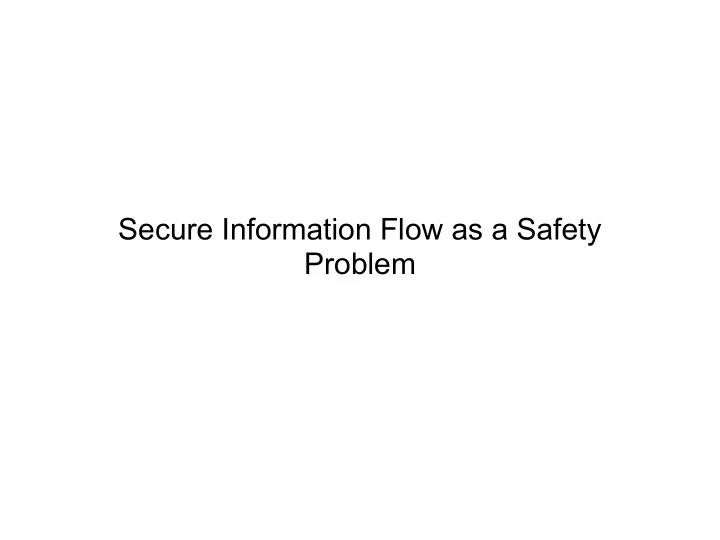

Secure Information Flow as a Safety Problem
Overview ● Introduction to secure information flow ● Type-Based approach ● Self composition ● Downgrading ● Self composition with downgrading ● Type directed transformation ● Conclusion
Introduction The termination insensitive secure information flow problem (non-interference) can be reduced to solving a safety problem via a simple program transformation. The transformation is called Self-composition. This paper generalizes this self-compositional approach with a form of information downgrading. The authors combine this with a type-based approach to achieve a better way to analyse software.
Secure Information Flow Definition Given a program P whose variables H = {h 1 , . . . , h n } are high security variables and L = {l 1 , . . . , l n } are low-security variables, P is said to be secure if and only if for any stores M 1 and M 2 such that M 1 = Hc M 2 , (<M 1 , P> ≠ ⊥ ∧ <M 2 , P> ≠ ⊥) ⇒ <M 1 , P> = L <M 2 , P>
Non-Interference (Vanilla)
Safety Problem A safety property is a property of a program that can be refuted by observing a finite path Non-interference is almost a safety problem The 2-safety property is defined similarly but the program can be refuted by observing two finite paths
Type-Based approach Evaluates statically if the low security variables is dependent of the high security variables. if(b) then x:=1 else skip l:=l+x; SAFE if(h) then x:=1 else skip l:=l+x; UNSAFE
Type-based limitation Type-based cannot show that the example is safe
Self-Composition Type Based can't verify the previous figure, that's why we use Self-Composition because? 1. let V(P) be all variables in P 2. C(P) is a copy of P where x ∈ V(P) is replaced by C(x) 3. For any stores M 1 and M 2 such that domain(M 1 ) = V(P) and domain(M 2 ) = V(C(P)), let M 1 = L M 2 before execution 4. Run P;C(P) 5. Check if <M 1 ,P;C(P)> = L <M 2 ,P;C(P)>
Self-Composition
Downgrading 1 Vanilla secure information flow is too strict. For example: if(hashfunc(input)=hash) then l:=secret else skip;
Downgrading 2 In order to ease on the restrictions, we need a downgrading function f hi for each high security variable h i that defines when and how a high security variable can be leaked. Example (same as last page): f = λx.if(hashfunc(input)=hash) then x else c More examples: f = λx.length(x) f = λx.0 (Vanilla)
Downgrading 3 A program F can be expressed as F(f(h 1 ) ... f(h n ))= F(e 1 ... e n ) and agree with P on low- security variables at termination. where e i is a security policy, that associates each high- security variable h i to a downgrading function f h The program F first evaluates the downgrading functions f (h 1 ) ... f(h n ) so the (h 1 ,...,h n ) are not mentioned in the running of the rest of the program. At termination <M,P> = L <M,F(e)>
Downgrading and self composition Above does not work with type based But it works with self composition Because type based is dependent on structure of downgrading operations
Self-Composition Problem Can't be verified with self-composition, but works with type-based.
Type-directed Transformation Both the type-based and the self-composition approach have their downsides. Type-directed transformation combines the best of two worlds. Using the WHILE-language to illustrate how it works.
While-language
Type-directed translation
Type-directed translation Example 1 Before: Rule: After:
Type-directed translation Example 2 Before: Rule: After:
Type-directed translation Example 3 Before: Rule: After:
Conclusion ● Type-directed transformation is better than the type based approach. ● But not much different to self-composed approach for a hypothetical analysis tool ● More digestible than self-composed ● Still not perfect.
Recommend
More recommend